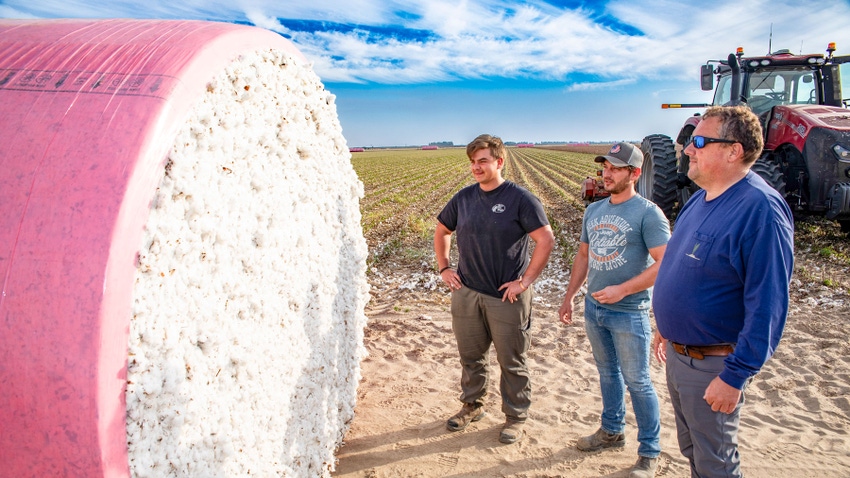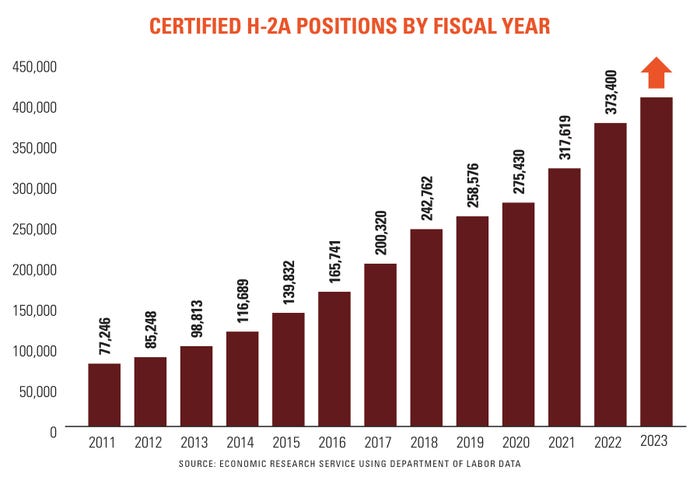
Certifications for H-2A — the Department of Labor’s temporary ag worker program — have increased sevenfold since 2005, says economist Marcelo Castillo at USDA’s Economic Research Service. H-2A jobs increased from 48,000 in 2005 to over 370,000 in 2022.
Foreign guest workers are found mainly in specialty crops that rely heavily on manual labor, but “by some estimates, H-2A workers now fill about 15% of U.S. jobs in crop agriculture, too,” Castillo says.

So what’s driving renewed interest in H-2A workers?
“The supply of immigrant farmworkers appears to be declining, especially from rural Mexico,” Castillo says. “Farm wages are rising in all regions. Besides falling Mexican fertility rates, there are better employment opportunities in the Mexican economy, along with stiffer immigration enforcement by the U.S. government.”
Brian Lisonbee, attorney and owner at Lisonbee Immigration Law, Lincoln, Neb., agrees.
“U.S. immigration has been tougher this year than they ever have before on immigration matters,” he says. “A lot of people were passionately angry with what the Trump administration did with immigration law and thought the Biden administration would make it easier, but we’ve seen it become a lot more difficult for people looking to find labor solutions.”
Farmers who want to expand their farm operation usually need more, not fewer, people. And it’s hard to substitute labor with technology, although that is improving.
Turning to the H-2A program can help solve labor problems, but it’s not just simply finding someone and hiring them. Department of Labor (DOL) rules follow:
Job must be temporary or seasonal, up to 10 months, with no caps on number of workers.
Employers must show, and the DOL must certify, the H-2A worker won’t negatively affect wages of U.S. workers.
Employers must prove a lack of U.S. workers to fill the job, and must try to recruit U.S. workers before hiring H-2A workers.
Workers must perform the specific number of hours in contract.
Employers must provide transportation to job and housing.
Employers must pay per-worker fees for processing ($100), filing ($460), agent ($100), consulate ($190) and costs for transport from home country to worksite.
Also, employers must pay a DOL-designated minimum wage, which varies in 18 regions across the U.S. California and the Midwest pay the highest per hour at $17.50 to $18.60 compared to the Southeast at $14.60. Wages increase in all regions, on average, 4% each year, Castillo says.
Steps to take
To jump into H-2A, you must file a labor certification with DOL. Once that’s complete, and you’ve advertised for the position and shown you have a need to hire these employees, you file an I-129 petition with U.S. Citizenship Immigration Service. It’s a straightforward process that can take months to complete, whether you or a lawyer manage the project.
“I would never tell somebody you have to hire a lawyer for any immigration service,” Lisonbee says. “If you’re a small outfit and can’t afford lawyer fees, don’t be afraid to jump into immigration.”
But “if you don’t have time for that and don’t want to mess something up and you’re worried about it, get a lawyer, or at least get somebody to consult with you to make sure you’re complying with the program,” he adds.
DOL has a list of certified agents that can help identify workers in other countries.
“The application process and regulations may seem like a lot to take on, but the rewards reaped far outweigh the initial effort, especially with the help of an experienced specialist,” says Todd Miller, CEO at Head Honchos, which specializes in finding foreign workers for U.S. farmers. “Hiring a specialist takes the guesswork out of the process, so employers can enjoy the fruits of their business’s harvests and rest easy knowing they’re following the program’s requirements.”
Are you eligible for H-2A help?
The Department of Labor offers these guidelines for H-2A eligibility:
Employer’s requirements. You must be an employer with a business physically located in the U.S., possess a valid federal employer identification number (FEIN), and have the ability to hire, pay, fire, supervise or control the work of the employees.
Type of work. The work to be performed must consist of agricultural labor or services, such as planting, raising, cultivating, harvesting or production of any ag or horticultural commodity.
Full-time work. The work must be full-time, at least 35 hours (or more) per work week.
Seasonal work. The need for the work must be seasonal or temporary in nature, and tied to a certain time of the year by a recurring event or pattern, such as an annual growing cycle, normally lasting 10 months or less.
Learn more about navigating the H-2A Program at the Farm Futures Business Summit in Coralville, IA, Jan. 9-11, 2024. Todd Miller will lead the breakout session "Solving the Ag Labor Crisis: How To Use the Government H-2A Foreign Worker Program" to discuss the secrets to finding and retaining quality employees to help you grow your business.
Read more about:
LaborAbout the Author(s)
You May Also Like






